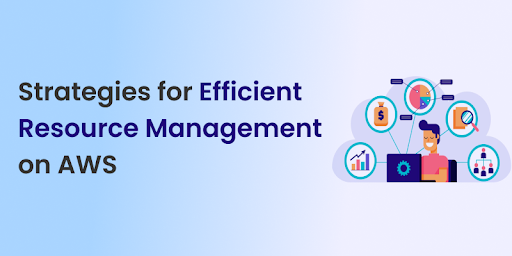Strategies for Efficient Resource Management on AWS

In cloud computing, Amazon Web Services (AWS) stands tall as a titan, offering various resources that empower businesses to thrive in the digital age. However, amid this abundance, the art of resource management emerges as a critical factor that can define the success of enterprises on AWS. Efficiently managing resources not only holds the potential to save costs but also unlocks enhanced performance and an elevated user experience.
In this blog, we delve into a crucial aspect of AWS strategy—strategies for achieving optimal resource management. By delving into the key principles and techniques, this article aims to equip you with the knowledge to navigate AWS resource management waters masterfully.
1. Rightsize Your Resources
AWS (Amazon Web Services) is a leading cloud computing platform, essential for businesses for scalable, cost-effective IT solutions. AWS Training and Certification empower professionals with expertise to effectively manage and utilize AWS services, driving innovation and efficiency.
One of the fundamental principles of efficient resource management on AWS is rightsizing. This involves selecting instance types that align with the actual requirements of your workloads. AWS provides a variety of instance families with different specifications, such as CPU, memory, and storage. It’s essential to regularly analyze your workload’s resource utilization patterns to identify over-provisioned or underutilized instances.
Leverage AWS CloudWatch to gather CPU utilization, memory usage, and network traffic metrics. Tools like AWS Trusted Advisor can offer insights into cost optimization by suggesting appropriate instance types based on historical usage patterns. By rightsizing your resources, you reduce costs and enhance overall system efficiency.
2. Implement Auto Scaling
Auto Scaling is a dynamic solution to ensure your application can handle varying workloads efficiently. By automatically adjusting the number of instances responding to demand changes, you prevent over-provisioning during peak times and underutilization during off-peak periods. AWS offers Auto Scaling groups that can be configured to maintain a desired number of instances based on predefined scaling policies.
When implementing Auto Scaling, consider setting up policies based on CPU utilization, network traffic, or other custom metrics. This ensures that your application scales seamlessly while maintaining optimal resource utilization.
3. Utilize Amazon S3 Lifecycle Policies
Amazon Simple Storage Service (Amazon S3) is a widely used storage solution on AWS. To optimize storage costs, leverage S3 lifecycle policies. These policies enable you to automatically transition objects between different storage classes based on their age and access patterns. For instance, you can move less frequently accessed data to cheaper storage classes like Amazon S3 Glacier or S3 Infrequent Access.
By using lifecycle policies, you keep frequently accessed data in high-performance storage while minimizing costs for long-term storage of less critical data.
4. Leverage AWS Lambda for Serverless Computing
AWS Lambda allows you to run code without provisioning or managing servers. This serverless approach is not only cost-effective but also ensures efficient resource allocation. With Lambda, you’re billed based on actual execution time and resources consumed by your functions. This fine-grained billing model eliminates the need to pay for idle resources.
Utilize Lambda for event-driven tasks, such as image resizing, data processing, and backend operations. By doing so, you reduce the operational overhead and maximize resource efficiency. Harness the power of AWS Lambda for serverless computing, eliminating server management complexities. Lambda’s pay-as-you-go model charges you solely for executed code, eradicating idle resource expenses. Opt for Lambda in event-triggered scenarios like image resizing, data processing, backend operations, streamlining operations, and optimizing resource utilization.
5. Monitor and Analyze
Continuous monitoring and analysis are crucial for maintaining efficient resource management on AWS. Leverage AWS CloudWatch to monitor various metrics and set up alarms to alert you when resource utilization exceeds predefined thresholds. Additionally, use AWS CloudTrail to gain insights into API activity, allowing you to detect unauthorized or inefficient resource usage.
Regularly review your monitoring data to identify trends and areas for improvement. Utilize this information to adjust your resource management strategies and optimize costs further. Maintaining vigilant monitoring and analysis is pivotal for sustained efficient AWS resource management. AWS CloudWatch aids in tracking metrics and setting up alerts for preemptive action, while AWS CloudTrail sheds light on API activity irregularities. Patterns emerge by consistently evaluating monitoring data, fostering proactive optimization of resource management and associated costs.
6. Implement Containers with Amazon ECS or EKS
Containers have revolutionized application deployment by providing consistent environments across development, testing, and production stages. AWS offers Amazon Elastic Container Service (ECS) and Amazon Elastic Kubernetes Service (EKS) for container orchestration.
Containers allow you to allocate resources precisely to match your application’s needs, preventing resource wastage. ECS and EKS enable you to scale containers dynamically, ensuring efficient resource utilization while maintaining application availability.
7. Reserve Instances and Savings Plans
AWS offers various pricing options, including Reserved Instances and Savings Plans, which provide substantial cost savings compared to On-Demand instances. Reserved Instances allow you to commit to a specific instance type and payment plan over a term. At the same time, Savings Plans offer flexibility by providing savings on various instance types.
Strategically choose the appropriate reservation or savings plan that aligns with your workload’s characteristics and demands. This commitment can lead to significant cost reductions in the long run.
8. Optimize Data Transfer and Content Delivery
Data transfer costs can contribute significantly to your AWS bill, especially if your application involves frequent data movement. To mitigate this, utilize Amazon CloudFront, AWS’s content delivery network (CDN). CloudFront caches content at edge locations, reducing the need for data transfer to the origin server and improving content delivery speed.
In addition, use Amazon Elastic Load Balancing (ELB) to distribute incoming traffic across multiple instances, ensuring efficient load distribution and optimized resource utilization. Effectively managing data transfer expenses is pivotal in AWS cost management. Leverage Amazon CloudFront to expedite content delivery by caching at edge locations, reducing origin server reliance. Amazon Elastic Load Balancing (ELB) optimizes resource use by evenly distributing traffic among instances, enhancing load management efficiency.
Conclusion
Efficient resource management on AWS is a multifaceted endeavor requiring rightsizing, automation, monitoring, and strategic decision-making. By rightsizing instances, implementing Auto Scaling, leveraging serverless computing, and utilizing various AWS services, you can optimize resource utilization, reduce costs, and improve the performance of your applications. Monitor your environment, analyze metrics, and fine-tune your strategies to adapt to changing demands and evolving best practices. With these strategies in place, you can harness the full potential of AWS while maximizing your return on investment.





